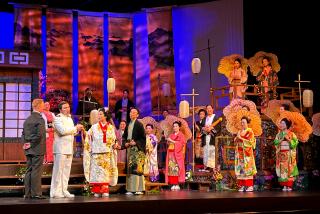Limon Troupe Puts Outsiders Center
- Share via
Three choreographers obsessed with outsiders made a challenging program by the Jose Limon Dance Company surprisingly unified on Friday in the Luckman Theatre at Cal State L.A.
Donald McKayle’s 2001 “Cross Roads” depicted a divided society defined by costume colors. You could think of his opposing cadres in brown or red as symbolizing racial differences, gang colors or social classes, but when Kimiye Corwin and Dante Puleio left their in-group partners for a relationship a la “Romeo and Juliet,” they became outcasts.
Robert Regala played a different kind of outsider: a rootless drifter with no allegiances or sympathies. His eccentric movement provided a new force field in contrast to the lovers’ increasingly defensive actions and the Browns’ and Reds’ oppressive group statements.
Besides these artful movement contrasts, “Cross Roads” proved compelling for its use of a James Newton jazz score, played live by Newton’s accomplished seven-member band. Often deceptively jaunty, the music also had edges and undercurrents, outbursts of drum thunder and sudden silences that signaled danger for those defying the power structure.
Taped jazz brought bounce and drive to Billy Siegenfeld’s postmodern 2001 suite, “If Winter,” which began with simple walking steps by dancers in street clothes, expanded to running steps and gestural motifs and culminated in full-fledged, loose-limbed dancing much later than you might expect.
Initially glimpsed in brief tableaux, Mary Ford represented rugged individualism in Siegenfeld’s universe--or perhaps symbolized the birth of spring. While everyone else huddled together in thick coats, she sensually stretched on the floor in body-hugging dance-wear. Eventually the group followed her example and liked it well enough to raise her on high in the happy, engulfing dances that closed the piece.
If McKayle’s and Siegenfeld’s outsiders embodied alternatives to a rigid, useless status quo, the loner in Limon’s own 1967 “Psalm” was carefully protected by the group as an acknowledged savior: one of the “36 just men” in Jewish tradition, or anyone as indispensable as Limon himself.
As always with Limon’s group pieces, the use of stage space and blocks of dancers--indeed, the whole sense of dance architecture--was a stunning achievement. In “Psalm,” his mastery transformed actions as simple as the unfolding of arms and as sophisticated as the waves of dancers that framed Regala’s outbursts.
However, the pain in the role, and Limon’s program note about “the heroic power of the human spirit, triumphant over death itself,” also expressed overwhelming personal issues. He was diagnosed with cancer in 1967 and soon stopped performing. In “Psalm,” he portrayed the central figure as violently troubled and left unanswered questions about the agony of exceptional outsiders in our midst--why their suffering seems to be in proportion to their gifts.
Artistic director Carla Maxwell recently restaged the work, replacing music by Eugene Lester with a new score by Jon Magnussen--a score arguably too conventionally religious for Limon’s unresolved statement of embattled faith. No church choir hallelujahs can relieve the darkness of his vision; we can only accept it as the unforgettably bleak expression of a great artist who died only five years later.
More to Read
The biggest entertainment stories
Get our big stories about Hollywood, film, television, music, arts, culture and more right in your inbox as soon as they publish.
You may occasionally receive promotional content from the Los Angeles Times.










